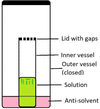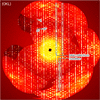issue contents
September 2024 issue

Cover illustration: The (3+1)-dimensional incommensurate structure of (2S,3S)-2-amino-3-hydroxy-3-methyl-4-phenoxybutanoic acid dihydrate (I·2H2O), in which one of the water molecules is disordered over two positions and each position exhibits occupational modulation, can be well refined in superspace, and in the average and supercell approximations. The occupational modulation of the disordered solvent water molecule results from the competition between the different hydrogen-bonding motifs associated with the two disorder positions of the water molecule. See Sanders, Bruffy, Buller, Petříček & Guzei [Acta Cryst. (2024), C80, 523–533].
scientific commentaries

electron diffraction


crystallography in latin america










research papers


 access
access

 access
access

 access
access







 access
access



 access
access
 journal menu
journal menu


































